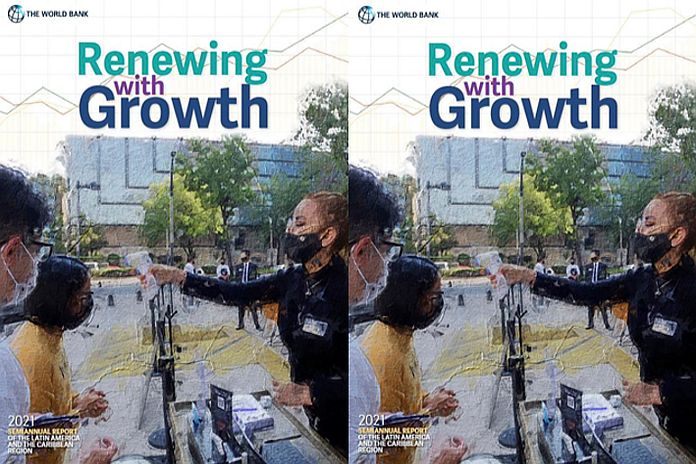WASHINGTON, USA — Latin America and the Caribbean (LAC) suffered more health and economic damage from the COVID-19 pandemic than any other region, although there is potential for significant transformation in key sectors as the region begins to rebound, according to a new World Bank report.
Because of the pandemic, Gross Domestic Product (GDP) in the Latin America and Caribbean region (excluding Venezuela) fell 6.7 percent in 2020. A return to growth of 4.4 percent is expected in 2021. That compares to the Bank’s late 2020 forecast of a 7.9 percent GDP decline in 2020, and 4 percent expansion in 2021.
The immense disruption from the pandemic may lay the groundwork for higher productivity through economic restructuring and digitization. Other growth opportunities stem from innovations in the electricity sector, according to the World Bank LAC Semiannual report Renewing with Growth.
“The damage has been severe and we’re seeing a lot of suffering, particularly among the most vulnerable,” said Carlos Felipe Jaramillo, World Bank Vice President for the Latin America and the Caribbean Region. “But we must always look ahead and seize on this opportunity to embrace the transformations needed to ensure a brighter future.”
The sharp contraction last year because of the pandemic had huge economic and social costs. Unemployment rates have generally increased and poverty rates shot up, although in some countries massive social transfers did much to cushion the social impact of the crisis.
The COVID-19 crisis will have a long-lasting impact on the economies of the region. Less learning and lower employment are bound to reduce future earnings, while high public and private debt may create stress in the financial sector and slow the recovery.
Despite the challenges, there are some bright spots. Global trade in goods held up relatively well, despite the sharp drop of trade in services, especially tourism. Most commodity prices are now higher than before the COVID-19 crisis, partly due to China’s quick rebound. This is good for exporters of agricultural and mining products. Remittances to the region are up compared to before the pandemic, which is very important to several countries in the Caribbean and Central America.
In addition, capital markets remained open to most countries in the region. Borrowing from abroad actually increased, which helped mitigate the economic and social impact of the COVID-19 crisis. Most countries in the region ran substantial budget deficits since the beginning of the pandemic, with the additional spending devoted to strengthening health systems, providing transfers to households, and helping firms. At the same time, proactive measures helped debtors and reduced the risk of financial crises.
“As economies rebound this year, some sectors and firms will gain and others will lose,” said Martín Rama, World Bank Chief Economist for the Latin America and the Caribbean region. “The pandemic has triggered a process of creative destruction that may lead to faster growth but may also amplify inequality within and across countries in the region.”
For example, hospitality and personal services may suffer long-term damage, but information technology, finance and logistics will expand. In the medium term, the gains could be larger than the losses. The biggest transformation could come from accelerated digitization, which could lead to greater dynamism in financial intermediation, international trade and labor markets.
Technology also brings the opportunity to transform the power sector. Latin America and the Caribbean has the cleanest electricity generation matrix of all developing regions, mainly due to the abundance of hydropower. The region should have the cheapest electricity in the developing world, but instead has the most expensive, mostly due to inefficiencies.
Firms and households in the region pay substantially more for the electricity they consume than it would cost to produce it. Inefficiencies are reflected in frequent power outages, technical and commercial losses, over-staffed state-owned utilities, and abuse of market power by private generators.
With the right institutional framework, technology could increase competition in the sector, bringing electricity prices down and increasing the share generated from renewable sources. For example, distributed generation could allow firms and households to rely on their own power sources, such as solar panels, to sell electricity to the grid or to buy from it depending on the hour of the day. In addition, increased cross-border electricity trade could capitalize on differences in installed capacity, generation cost and the timing of peak demand to generate mutual gains. However, these efficiency gains will only materialize if electricity can be sold and bought at the right price.
While there are signs that the economies of the region are rebounding and hopes that the disruption could have some positive outcomes, the outlook for this year remains uncertain. Vaccine rollout has been slow in most of the region, and herd immunity may not be attained before the end of 2021 at the earliest. In addition, new waves of infection may come as new variants of the virus emerge. While actively preparing to build back better, protecting lives and livelihoods remains the priority.
Link to the full report, Renewing with Growth





